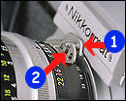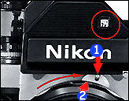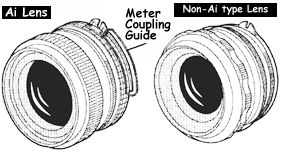The legendary Nikon F SLR camera was first introduced back in 1959. Years that followed, development of Nikon SLR cameras has enabled every camera model is easy to operate and incorporating newer features and accessories to made them more responsive to operate and accurate in achieving rewarding photography.
One gray area was the lens compatibility. Unlike many other major camera brands which have abandoned the support of manual focus lenses when converting to autofocus with a new lens mount for the autofocus optic; technically, with the exception of some special application lenses developed during the prevailing period of camera/metering development, you can still mount a 40 odd years Nikkor lens onto a made-in-year-2002 SLR camera model such as the Nikon FM3A and takes pictures with it because despite the decision to turn commercial interest over to development of autofocus, Nikon has decided to retain the F-Mount and enables newer and older series of lenses still able to be used* on older and newer camera bodies - that essentially has made Nikon photographic system such a joy to use and pride to own.
However, one feature that has great commercial marketing interest for SLRs during those early days was how to get a metering built into the camera body to meter through the actual picture taking lens without the hassle of using external metering devices to hand check exposures. Nikon adopted a mainstream method (pioneered by Asahi Pentax Optical Ltd.) called "open aperture metering" or "full aperture metering"*, which means the camera will activate the lens in use with its largest aperture to maintain brightest light entry into camera with the purpose of comfort viewing, accurate focusing and picture composing prior to actual picture taking, the lens will only "stopped down" the actual aperture value that a user pre-selected on the lens only during time of exposure. Don't be surprise Because until today, virtually ALL modern SLR cameras are still using the open aperture theory for their respective metering systems.
 |
Confused ? Okay. This is the a typical manual focus Nikkor lens and illustration of the diaphragm inside the lens to "control" the amount of light entering the lens/camera. Next if the flow chart of how a SLR works pre and during an exposure process. |
Exposure can be controlled by determine the shutter speed selected on the camera portion in combination with the aperture used on the lens section. The larger the lens opening (via diaphragm blades inside the lens) more light will enter onto film when the shutter curtain in the camera "opens", smaller the lens diaphragm, lesser amount of light will penetrate during the exposure process. Together with the shutter speed on the camera section that also serves similar objective of control the amount of light and effect of an eventual image (slower shutter speed used which controls the duration of the shutter curtain opening will allow more light to expose on the film; while on the other hand, faster shutter speed which has a shorter duration of shutter curtain opens will restrict the light exposing onto film emulsion), both lens diaphragm (via aperture in used) and duration of the shutter curtain remains opens will determine the "correctness" of any given exposure.
 |
 |
 |
 |
| Viewing, ambient light metering through the Lens (TTL) via metering cell(s) (Purple dot). Lens open up at maximum aperture for bright viewing/focusing/composing. |
|
Shutter curtain closes, reflex mirror stays down, back to TTL viewing. Lens diaphragm revert back to full aperture. | |
An interesting question may pop up from your mind. Since full aperture is not that "faithful", can't we just stopped down the lens to the pre-selected aperture value and obtain a more "accurate" exposure calculation ?
Yes and NO.
 |
 |
Early full aperture metering system employed in older Nikon SLRs was activated by using lever and pin on the camera (1) which mated with the lens meter coupling shoe on the lens (2). |
In 1977, a major breakthrough occurred where Nikon introduced a new method called "Automatic Maximum Aperture Indexing" short for "Ai" where the mechanism is concealed inside the lens mount . The camera has substituted the external coupling by a springed meter coupling ring integrated with lens mount with an aperture stopped down lever resided at the side of the mirror box but a more tedious workout was on the lens section, in order to have the automatic indexing to work, it would require all older "non-Ai" conformed Nikkor lenses modified and added with a meter coupling ridge on the lens section in order to take advantage of the Ai equipped Nikon SLR camera bodies. Good news was, Nikon was considerate enough as newer marketed Ai lenses which has the meter coupling ridge built-in can still be used on older Non-AI-spec Nikon cameras because the meter coupling shoe on the lens is retained on newer series of AI lenses and thus they can still coupled to the older cameras to perform semi-automated full aperture metering.
Such modified Nikkor lens was generally being referred as "AI-modified" or some called them as "AI'd" Nikkor lenses (Curious to find who was the genius setting such an odd and unrelated term...). All manual focus Nikkor lenses produced since then were assumed to be carried with a Ai specifications. Even thereafter, there were two updates done to the MF (manual focus) Nikkor lenses by Nikon and eventually the arrival of autofocus era which has brought us the Nikkor autofocus lenses. As FAR AS the Nikon F3A is concerned, other than some older versions of long been discontinued Nikkor lenses and some that carried specific design (see bottom section for more info) which are not suitable to be used with the FM3A; basically, it only requires a minimum specification of Ai and it should work with its metering system.
However, please note that many series of Nikkor lenses such as Series E and ALL AF-Nikkor lenses does not have the meter coupling shoe on the aperture ring which I think the removal was more of a commercial decision because technically, it is still possible to add a shoe a top in order to permit these lenses couple to the metering system of old Nikon non-AI SLR bodies. Well, this is tedious and costly, but you can still mount and used them without any metering guide or in some cases, the stopped down metering mode can still be functional.
Now, here
comes some questions that you may be asking:
Can all the AF Nikkor lenses be used on the FM3A ?
Will all manual focus Nikkor lenses work with the FM3A and what are the compromises?
How to identify them ?
Any websites around featuring the older Nikkor Lenses ?
In the instruction
manual, Nikon clarifies:
Any of the following lenses can be used with this camera.
|
Exposure mode / Lens Combination |
Aperture-Priority
|
Manual Mode |
Remarks |
| CPU lenses: • D-type AF • Non-D-type AF • Ai-P •PC Micro 85mm f/2.8D |
Yes |
Yes *a |
|
| Non CPU lens: • Ai-S • Ai / Ai-modified • Series E |
Yes |
Yes |
|
| Medical Nikkor 120mm f/4.0 |
No |
Yes *b |
|
| Reflex lenses |
Yes |
Yes |
|
| PC lenses |
Yes *c |
Yes *d |
Stop-down Metering |
| PB-6 Bellows Focusing Attachment |
Yes *e |
Yes |
Stop-down Metering |
| Nikkor IX lenses designed for APS Format SLRs |
No |
No |
|
| G-type Lenses designed for AF SLRs |
No |
No |
*a: When using the PC Micro 85mm f/2.8D, only manual exposure can be used. When shifting and/or tilting the camera, or when using an aperture other than the full aperture, flash compensation does not work.
*b: Only manual exposure is enabled. Usable with shutter speeds under 1/125 second.
*c: In aperture-priority auto exposure, first preset the aperture on the lens, then shift and/or tilt the camera.
*d: In manual exposure, first preset the aperture on the lens, then measure the light to determine the exposure before shifting and/or tilting the camera.
*e: First make the aperture setting for the bellows focusing attachment, then measure the light and shoot.
Nikon also advises that certain older versions of Nikkor lenses and accessories CANNOT be attached to this camera. (if you try to forcibly attach them, the camera and/or lens may be damaged.)
# TC-16A Teleconverter
# Non-Ai-modified lenses
# Lenses used with the AU-1 Focusing Unit (400mm f/4.5, 600mm f/5.6, 880mm f/8.0 and 1200mm f /11)
# Fisheye lenses (6mm f/5.6, 75mm f/5.6, 8mm f/8.0 and OP 10mm f/5.6)
# Old-type ultra-wideangle Nikkor 21mm f/4.0
# K2 Extension Ring
# ED 180-600mm f/8.0 (Product No. 174041-174180)
# ED 360-1200mm f /11 (Product No. 174031-174127)
# 200-600mm f/9.5 (Product No. 288001-300490)
# 80mm f/2.8, 200mm f/3.5, and TC-16S Teleconverter for Nikon F3AF
# PC 28mm W (Product No, 180900 or smaller)
# PC 35mm f/2.8 (Product No, 851001-906200)
# Old-type PC 35mm f/3.5
# Old-type Reflex Nikkor 1000mm f/6.3
# Reflex 1000mm f/11 (No. 142361-143000)
# Reflex 2000mm f/11 (No. 200111-200310)
 |
How to distinguish Ai-type lenses from Non-Ai-type lenses ? (More info & Illustrations) |
There are PLENTY of high quality websites featuring older Manual Focus Nikkor lenses on the Network. Some of them have other useful references relating to this topic:
http://www.zi.ku.dk/personal/lhhansen/photo/fmount.htm by: Hansen, Lars Holst
http://www.cameraquest.com by: Stephen Gandy Roland Vink
http://www.home.aut.ac.nz/staff/rvink/nion3.html by: Stephen Gandy
http://www.mir.com.my/rb/photography/hardwares/nikonfmount/lens2.htm
I do have
another smaller section contributing to this specific topic, please refer to
| c l o
s e |
Standard
production Nikon FM Series models:-
Nikon FM | Nikon FM2 | Nikon FM2n | Nikon FM10 | Nikon FM3a |
Known
variants:-
Nikon
FM Gold
| Nikon
FM2/T
| Nikon
FM2N Tropical Set
| Nikon
FM2/T Limited Edition
| Nikon
FM2N LAPITA
|
Nion
FM2n Millennium 2000
|
Back | Index Page of Instruction
Manual Section of Nikon FM3A
|
Back | Index Page - Other
Issues < Index Page >
| Message Board | for
your favourite Nikon
FM Series SLR models
| Message
Board | for your Nikon
Optics in a shared environment
| Message Board | Specifically for Dispose or Looking for Nikon/Nikkor
Photographic Equipment
| Back | Main Index Page of Nikon FM series Bodies
Shared Resources: MD-11 | MD-12 | Focusing Screens | Titanium Shutter | ORIGINAL dedicated Flash Units -SB-16 | SB-15 | SB-10 or other Options | Databack | Nikkor lens mount (related info)
Others:- Nikon AF-TTL Speedlights
| SB-20 (1986)
|
SB-22
(1987)
| SB-23 | SB-24 (1988) |
SB-25 (1991/2) |
SB-26 (1994)
| SB-27(1997)
| SB-28 (1997) |
Nikon
SB-29(s)
(2000) |
Nikon
SB-30
(2003) |
Nikon
SB-600
(2004) |
Nikon
SB-800 (2003)
(updated)
Nikon AF-TTL Speedlight DX-Series: Nikon SB-28DX (1999)
| SB-50DX (2001) |
SB-80DX
(2002)
(updated)
Nikon
BC-flash Series |
Original Nikon Speedlight
SB-2
| SB-3
| SB-4
| SB-5
| SB-6
| SB-7E
| SB-8E
| SB-9
| SB-E
| SB-10
SB-11
| SB-12 | SB-14 | SB-140 UV-IR| SB-15 | SB16A | SB-17 | SB-18, SB-19 | SB-21A (SB-29) Macro flash | Flash Accesories | SF-1
Pilot Lamp
Instruction
Manual: Nikon FM (HTML | PDF) | Nikon FM-10 (HTML) | Nikon FM2n's
User's Manual
available only in HTML format (6
parts) | Nikon FM3A (HTML)
Specifications: Nikon FM, FM-10, FM2, FM2n and FM3A
Main Reference Map: (HTML) Nikon FM, FM2, FM-10, FM2n (Applicable
to FM2T, FM2 "Year of the Dog"; Millennium 2000") and FM3A
| Nikon F | Nikon F2 | Nikon F3 | Nikon F4 | Nikon F5 | Nikon F6 | Nikkormat / Nikomat | Nikon FM | Nikon FE/ FA | Nikon EM/FG/FG20 | Nikon Digital SLRs | Nikon - Other models |
Nikon Auto Focus Nikkor lenses:- Main Index Page
Nikon Manual Focus Nikkor lenses:- Fisheye-Nikkor Lenses - Circular | Full Frame |
Ultrawides Lenses - 13mm15mm18mm20mm | Wideangle Lenses - 24mm28mm35mm | Standard Lenses - 45mm 50mm 58mm | Telephoto
Lenses - 85mm105mm135mm180mm & 200mm | Super-Telephoto Lenses - 300mm 400mm 500mm 600mm 800mm 1200mm |
 Index Page |
Special
Application lenses: Micro-Nikkor Lenses - 50mm~55mm -60mm 85mm -105mm 200mm Micro-Zoom 70-180mm Perspective Control (PC) - 28mm 35mm PC-Micro 85mm Dedicated Lenses for Nikon F3AF: AF 80mm f/2.8 | AF 200mm f/3.5 EDIF Depth of Field Control (DC): 105mm 135mm Medical Nikkor: 120mm 200mm Reflex-Nikkor Lenses - 500mm 1000mm 2000mm Others: Noct Nikkor | OP-Nikkor | UV Nikkor 55mm 105mm | Focusing Units | Bellows-Nikkor 105mm 135mm Nikon Series E Lenses: 28mm35mm50mm100mm135mm | E-Series Zoom lenses: 36~72mm75~150mm70~210mm |
MF Zoom-Nikkor Lenses: 25~50mm | 28~45mm | 28~50mm | 28~85mm | 35~70mm | 36~72mm E | 35~85mm | 35~105mm | 35~135mm | 35~200mm | 43~86mm | 50~135mm | 50~300mm | 70~210mm E | 75~150mm E | 80~200mm | 85~250mm | 100~300mm | 180~600mm | 200~400mm | 200~600mm | 360~1200mm | 1200~1700mm
Tele-Converters: TC-1 | TC-2 | TC-200 | TC-201 | TC-300 | TC-301 | TC-14 | TC-14A | TC-14B | TC-14C | TC-14E | TC-16 | TC-16A | TC-20E
Recommended links to understand more technical details
related to the Nikkor F-mount and production Serial Number:
http://rick_oleson.tripod.com/index-153.html by: my
friend, Rick Oleson
http://www.zi.ku.dk/personal/lhhansen/photo/fmount.htm by: Hansen,
Lars Holst
http://www.mir.com.my/rb/photography/hardwares/nikonfmount/lens2.htm
http://www.photosynthesis.co.nz/nikon/serialno.html
W A R N I N G: The New G-SERIES Nikkor lenses have no aperture ring on the lens, they CANNOT ADJUST APERTURES with any of these manual focus Nikon FE series SLR camera models; please ignore some portion of the content contained herein this site where it relates.
|
Back | Main Index Page of Nikkor Resources
|
Back | Main Index Page of Pictorial
History of Nikon SLRs
| Message Board | for your Nikkor optics ("shared" because I do wish some of you to expose to other's perspective as well. Isn't it a sad sate to see photography has to be segmented into different camps from the use of various labels)
about this photographic web site
Home - Photography in Malaysia |
Credit: To all the good people who has contributed their own experience, resources or those who are kind enough granting us permission to use their images appeared in this site. Mr. MCLau®, who has helped to rewrite some of the content appeared this site. Chuck Hester® who has been helping me all along with the development of all these Nikon websites;LarsHolst Hansen, 'Hawkeye' who shares the same passion I have; Ms Rissa, Sales manager from Nikon Corporation Malaysia for granting permission to use some of the official content; TedWengelaar,Holland who has helped to provide many useful input relating to older Nikkor lenses; Some of the references on production serial numbers used in this site were extracted from Roland Vink's website; HiuraShinsaku from Nikomat Club Japan. t is also a site to remember a long lost friend on the Net. Note:certain content and images appeared in this site were either scanned from official marketing leaflets, brochures, sales manuals or publications published by Nikon over the years and/or contribution from surfers who claimed originality of their work for educational purposes. The creator of the site will not be responsible for may discrepancies arise from such dispute except rectifying them after verification."Nikon", "Nikkormat", "Nippon Kokagu KK" & "Nikkor" are registered tradename of Nikon Corporation Inc., Japan. Site made with an Apple IMac.